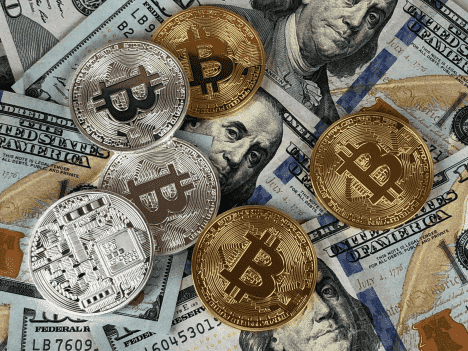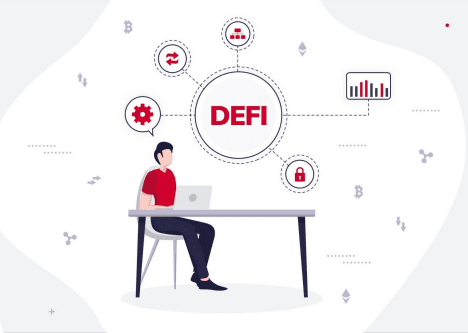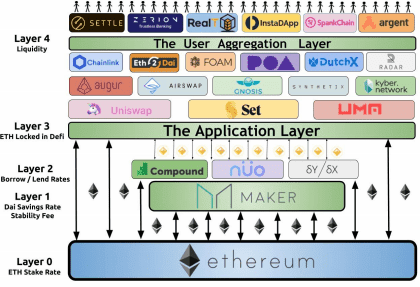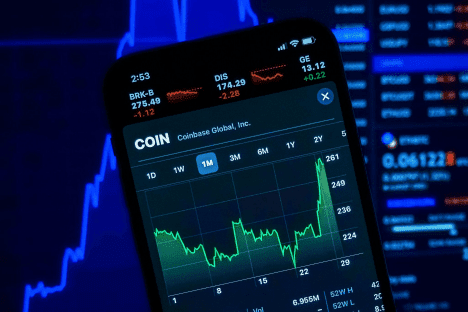Let’s bust the crypto hype & get real. This blog explores what DeFi is & what it can do.
Do you wish to provide your customers a more robust, secure, and real-time global financial system to avail financial services?
DeFi is the answer!
DeFi, what?
DeFi apps, or Decentralized financial applications are built on blockchain platforms to replicate traditional financial instruments without any custodians i.e., traditional centralised authorities.
We are embarking into a world with open finance. Of-course making any authoritative predictions right now about this new financial world would be naive, and such predictions just add up to the already over-inflated fuss. But yeah, it’s quite visible that Decentralized Finance (DeFi) is laying the groundwork for the financialization of everything! Code-governed financial applications are-
- Enabling companies to stream salaries to their employees in real-time,
- Empowering digital content creators to generate new income channels,
- Facilitating individuals to lend/borrow/pay millions without having to identify themselves
Yes. Using these new-age open finance technologies built on platforms like Ethereum, multi-chain, and Solano, we can perform traditional financial activities like lending, borrowing, investing in indexes, derivatives, deposit and earn interest rates, payments, etcetera.

In short, with DeFi apps, we get blockchain-powered security, transparency, and control over our financial assets.
So, no cons with DeFi?
Not much but ultimately the immutable digital ledgers, smart contracts are developer written lines of code.
So, there is still some vulnerability associated with DeFi apps in terms of code bugs. Still, these vulnerabilities should disappear as the ecosystem matures. What makes me say that? DeFi apps are open-sourced and the pool of developers scrutinizing these apps and updating bugs would become bigger and bigger with time. This would definitely enhance the technical security aspects of DeFi apps.
In case you’re still wondering what’s driving all the hype about DeFi, DeFi protocols-powered applications have grown 20x over the past year and command collateralized assets worth $55Bn+, total value locked (TVL) in DeFi apps is estimated around $99.47Bn+.
Read this insight to get a thorough understanding of the DeFi applications. First, we take some inspiration from what the industry is already building and then we dive into how you can build your own DeFi application
Popular DeFi Apps

Before venturing into something, it’s always a good idea to observe what the leading players in the industry are doing, and especially if you are developing a DeFi application, it’s good to research your competitors, validate your idea, and then jump in.
DeFi apps use smart contracts. Most of the popular DeFi apps are built on the Ethereum blockchain, which uses ‘Ether’ as its native currency. FYI, ‘Ether’ is the second-largest cryptocurrency after Bitcoin. Uniswap, Sushiswap, 1inch, 0x API, Balancer, Compound, Kyber, MakerDAO are some of the wildly popular DeFi apps out there. Let’s explore some of these and find out what your peers are up to:
MakerDAO

MakerDAO is a two-token powered protocol. First, DAI is a collateral-backed stablecoin, and second is MKR i.e., a governance token used by Maker stakeholders to manage Maker protocol. DAI is soft-pegged to the US dollar, which basically means that DAI value remains relatively stable with the Dollar value.
USP: Users can create and own Maker Vaults, which are collateralized debt positions. Users can deposit ETH or other accepted tokens as collateral and generate DAI in return. The Maker protocol controls the number in circulation to keep a tap on the stability of DAI. If the fluctuations in deposited collateral are observed beyond a “settlement ratio”, the respective vault gets automatically liquidated.
Use case: MakerDAO’s DAI is widely used to hedge against the fluctuations in the cryptocurrency market, and to borrow loans as well.
MakerDAO controls over $7 billion worth of tokens on the network.
SushiSwap

SushiSwap is an Ethereum based, Decentralized Exchange (DEX) forked from Uniswap. It enables users to trade, lend, borrow, and leverage crypto assets without any intermediaries like Coinbase and Binance. SushiSwap’s TVL is $3.11Bn+.
InstaDapp
Are you aware that InstaDapp, an idea that sprouted in an ETH hackathon, has a value of over $9 billion? Guess what, one of the co-founders is a school dropout. And the other one is a college dropout.
InstaDapp features a user-friendly interface that allows users to manage their DeFi investments across protocols like Maker, Uniswap, and Compound, which is ideal for newcomers to the DeFi industry.
DeFi Trends
Stablecoins
Stablecoins, as their name suggests, attempt to create price “stability.” Stablecoins are cryptocurrencies linked to non-crypto currencies, such as the US dollar, to maintain a stable price.
Why might Stablecoins be a great choice for you?
Stablecoins have a lot going for them right now, as they are still expanding despite market cap losses. For instance, Tether (USDT) has crossed the $60 billion market value level.
In addition, USD Coin (USDC) is ranked tenth among the top ten most valuable cryptocurrencies by market capitalization.
Neobanks
Did you know that, between 2019 and 2026, the global neobank market is predicted to exhibit a CAGR of roughly 46.5 percent, producing around USD 394.6 billion by 2026?
What makes Neobanks different from physical banks is that the former conducts all of its banking operations online rather than through physical branches. Also, Neobanks are customer-centric -providing individualized online services to its consumers.
Liquidity mining
Liquidity Mining is when DeFi applications offer free tokens to encourage people to their platform. This has been the most publicized method of yield farming so far.
Moving on further, let us now dive deeper into the technical aspects of DeFi app development.
How to build DeFi dApps?

Here’s a brief guide to DeFi Tech Stack:
Four Layers Of DeFi Tech Stack
Layer 0, Settlement Layer:
Serving as the foundation for all other DeFi transactions, this layer is made up of a public blockchain and a digital money or cryptocurrency.
Ethereum and its native token ether (ETH), which is traded on crypto exchanges, are an example of the settlement layer. Tokenized forms of assets, such as the US dollar, or tokens that are digital representations of real-world assets, can be used in the settlement layer.
Layer 1 + Layer 2, Protocol Layer:
DeFi protocols are interoperable– they can be utilized by many businesses to create a service or app at the same time. The protocol layer gives the DeFi ecosystem liquidity.
Synthetix, an Ethereum-based derivatives trading platform, is an example of a DeFi protocol. It’s utilized to make digital replicas of real-world things.
Layer 3, Application Layer:
Consumer-facing applications are housed under the application layer, as the name suggests. This layer hosts the majority of the bitcoin ecosystem’s apps, including decentralized cryptocurrency exchanges and lending services.
Layer 4, User Aggregation Layer:
Aggregators connect numerous apps from the preceding layer to give a service to investors in the aggregate layer. They might, for example, make it possible to shift money seamlessly between different financial products in order to maximize profits.
On the aggregation layer, ‘lending’ and ‘borrowing’ are two examples of services. Other examples include banking services and cryptocurrency wallets.
Are you planning to build your own DeFi app?
Well, we have curated a list of the top platforms for developing a DeFi app.
Top Platforms For DeFi Apps
Ethereum:
One of the most popular choices when looking for a blockchain platform, the Ethereum network has already developed a large number of decentralized applications (dApps).
Did you know that around April 2021, the price of Ethereum (ETH) in US dollars continued to rise, hitting a high of over 2,500 US dollars at one time?
At the root of this growth is Ethereum’s one-of-a-kind contribution- the invention of the EVM, which led to the widespread use of smart contracts. Smart contracts on Ethereum necessitate a thorough understanding of Solidity or Vyper.
Near
A direct competitor to Ethereum 2.0(currently in development), the Near network is considered the finest blockchain platform for constructing a decentralized application if you want users to benefit from “progressive UX” and mobile adaptability while ensuring a fork and hacking-resistant environment.
EOS
If you are looking for a smart affordable solution for building a DeFi application, EOS is the right choice!
Projects with limited budgets or small-to-medium solutions may profit greatly from this platform.
Solana
Working at a lightning-fast pace, Solana is a high-performance blockchain network. Gulf Stream’s usage allows it to conduct over 50 thousand transactions per second while maintaining a high level of security for its consumers. Amazing, isn’t it?
Now that you have a good understanding of DeFi App development, let’s look at some of the DeFi use-cases and benefits.
Why DeFi?
Financial systems and organizations around the world seem to be doing fine. Then how does DeFi suddenly become a buzzword?
Amidst a tumbling global economy, worsening global healthcare, uncertain market sentiments, and ever-volatile crypto trading, DeFi stood resilient. Of course, it did get a few jolts too but the transparency and community-led control of this programmable finance did catch the attention of venture capitalists and retail investors alike.
DeFi Features & Benefits

Transparency:
Retail players have no control over banking service provider companies in the traditional finance setup. Enter DeFi. Open-sourced Protocols running on public blockchain ledgers, controlled by smart contracts in DeFi apps assure high levels of transparency.
Globally accessible:
30-40% of the world population is unbanked, financially excluded. But Internet penetration is improving globally. And these open-source blockchain-powered decentralized financial apps can be accessed by anyone with an internet connection and a digital device. As there is no intermediate regulatory organization, the entry barriers are very low. This enables DeFi apps to be globally accessible and boosts up global financial inclusion.
Immutability:
All data is saved in the blockchain ledger’s immutable storage, ensuring that no data is ever lost or tampered with.
Do read our insights on blockchain to understand how immutability is ensured and some tech aspects of blockchain with it’s use-cases in the agriculture industry.
Programmability:
This relates to DeFi App development’s high level of flexibility, which makes smart contract construction effortless.
DeFi, Industry use-cases, and applications

Based on what we’ve seen thus far, DeFi has the potential to transform traditional finance. However, like with any new innovation, DeFi’s promise extends beyond simply improving on the current state of affairs. Its true strength rests in its ability to disrupt the market by enabling new forms of financial goods, services, and offerings. Even at this early level, technology shows a lot of potential in this area. It’s already transforming how people manage their assets, borrow and lend money, and trade online. Let’s take a look at high-level use-cases of DeFi apps.
Lending and borrowing
DeFi has facilitated the creation of peer-to-peer lending and borrowing solutions that benefit the end-user significantly. This makes the process much cheaper and faster while still ensuring the protection of the transaction’s counterparties. Other advantages include faster transaction resolution and improved accessibility.
Check out how Codewave created an online peer-to-peer lending platform for a Fintech startup Finzy.
Savings
Owing to the growing popularity of DeFi lending services, people can now manage their funds in innovative ways. Users start collecting interest on their crypto assets by locking them into lending protocols like Compound.
Tokenization
Tokenization, one of the most important trends in blockchain, has emerged as a result of the Ethereum boom a few years ago. Utility tokens that are exclusive to a dApp, security tokens that are similar to digital shares, real estate tokens that allow fractional ownership of physical properties, and other types of tokens are available.
Marketplaces
DeFi is also having an impact on how we buy and sell things online. Decentralized exchanges (DEX), which allow for peer-to-peer trading of digital assets, are a good example of this.
Types of DeFi Apps you can build

Let’s take a closer look at some of the different categories of DeFi apps in the market catering to various user need:
Borrowing and Lending DApps
Borrowing and lending DApps allow you to do exactly that – borrow and lend cryptocurrency. A smart contract is used to arrange the loan agreement. From the lender’s perspective, adopting these DApps offers the benefit of allowing you to earn interest on the crypto you lend, and there is only a minor danger of the assets not being repaid due to over-collateralization.
Using these DApps has the advantages of no credit checks, minimal transaction fees, and rapid settlement from the borrower’s perspective.
Compound and Aave are two examples of borrowing and lending DApps.
Decentralized Exchanges (DEXes)
One can trade digital assets amongst themselves using decentralized exchanges (DEXes), which eliminates the requirement for a central body to keep or deposit cash. Instead, users connect their wallets to the exchange and then validate the transaction.
DEXes have the advantage of having low trading fees due to their low maintenance. Furthermore, smart contracts are deemed quite safe as long as they are sturdy.
Some popular DEXes include Uniswap and dYdX.
Insurance DApps
Taking out insurance to cover digital assets can provide investors with peace of mind. This might include, for example, a defect in a smart contract or a hack on the blockchain. Some Dapps, on the other hand, provide protection for actual events in the same way that traditional insurance does, such as airline delays.
Nexus Mutual and Etherisc are two examples of insurance Dapps.
Payment DApps
DeFi provides secure payment solutions for people and organizations using open-source technologies. Blockchain technology helps to avoid fraud, provides banking services to those who have never had access to them, and allows for payment in a variety of cryptocurrencies and digital tokens. The best part? It allows for immediate processing.
Flexa is an example of a payment Dapp.
Prediction Market DApps
Using Prediction Market DApps, you can forecast election results, sporting events, and even future changes in the crypto world.
Augur is an example of a prediction market Dapp.
Wallet DApps
Wondering where to keep your cryptocurrencies and tokens in order to use DApps? Wallet Dapps is a solution to this problem. They are available for download as a browser add-on. Users can also sync their wallet Dapps with other Dapps to facilitate transactions.
MetaMask and MyEtherWallet are two examples of wallet Dapps.
Wrapping it up!!
Given DeFi’s phenomenal rise in 2020, it’s safe to say DeFi apps are going to influence the future of finance. Although 2021 might bring new obstacles, in DeFi, new opportunities might emerge as well.
We’ve attempted to cover nearly everything there is to know about certain popular DeFi apps, DeFi trends, DeFi tech stack, well-known DeFi app-building platforms, and so on in this blog. Hope you found it useful. Share with your peers.
If you’re looking for someone to design a custom DeFi app for you, Codewave will be your perfect partner in crime! At Codewave, we’ve completed over 300+ digital transformation projects across 10+ industries and assisted businesses in becoming more resilient, agile, and inclusive.
Here are some of our interesting projects.
Get in touch with our developers and experts right away to build your DeFi app with a high-performing, and secure tech stack.
Frequently Asked Questions(FAQs)
How do I create a DeFi app?
There are four layers of defi tech stack that you need to develop for creating a DeFi app: settlement layer, protocol layer, application layer, user aggregation layer. You develop defi app on top of blockchain platforms like Ethereum, Solana, etcetera.
How long does it take to build a DeFi app?
Ideally, a decentralized app development project would span between 4 months to 10 months. It is highly dependent on the team size, the set of features required, and the level of third part integrations.
What is protocol in DeFi?
DeFi protocols are a set of rules / standards / principles that define how certain financial activities can take place on a specific DeFi app. Maker, Synthetix, Curve, Sushiswap, Compound, are some of the popular protocols used by many DeFi platforms.
Daivi is a tech wizard, an avid reader, and a creative writer.







